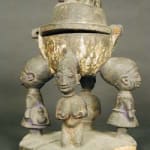Yoruba Wooden Shrine Box, 20th Century CE
Wood
8.25 x 13
PF.4365 (LSO)
Further images
This impressive sculptural vessel was made by the Yoruba group of Nigeria. It comprises a circular base with a hatched edge, supporting two standing, one kneeling and one seated (on...
This impressive sculptural vessel was made by the Yoruba group of Nigeria. It comprises a circular base with a hatched edge, supporting two standing, one kneeling and one seated (on a stool). The seated and kneeling figures are female, the others male. The women are naked, the men wearing what appear to be skirts. Their heads are crowned with high crested coiffures, and support an urn-like vessel with a high lid, topped with a leonine animal (perhaps a leopard). The figures are unpainted, but retain some blue paint – perhaps Reckitts Blue laundry dye – while the vessel itself is painted with some pale pigment. The piece is patinated with use wear, in addition to minor chips and stable age cracks.
The Yoruba peoples of Nigeria have what is probably the longest extant artistic tradition in Africa. The nation state is comprised of numerous subsections that were joined historically by the rise and collapse of the Ife (12th to 15th centuries) and Benin (13th to 19th centuries) polities. Each of the sub-kingdoms – including Oyo, Ijebu and smaller units towards the west – had their heyday, and are loosely united through language and culture, although they still retain a measure of independence in terms of their artistic traditions.
The Yoruba are sedentary, agriculturist and hierarchical, and are ruled by hereditary kings known as Obas. Access to the supernatural world is supervised by a very complex arrangement of priests and spiritual intermediaries, who straddle the cosmological border between the tangible realm of the living (aye) and the invisible realm of the spirits and the hereafter (orun). The creator of the world is Olodumare – the source of all ase (life force) – and his spiritual minions include all manner of spirits, gods and ancestors who can be appealed to or appeased through human intermediaries. Most Yoruban artistic heritage is designed to thwart evil spirits, and to placate or honour those that bring good fortune to the populace.
Without contextual information, the function of this item is uncertain. Given its dimensions, it is unlikely to be a domestic food container, and it is instead more likely to have occupied a ritual role, or perhaps for the storage of precious items in the same manner as Akan people store their valuables in kuduo vessels. This is an impressive piece of African art.
The Yoruba peoples of Nigeria have what is probably the longest extant artistic tradition in Africa. The nation state is comprised of numerous subsections that were joined historically by the rise and collapse of the Ife (12th to 15th centuries) and Benin (13th to 19th centuries) polities. Each of the sub-kingdoms – including Oyo, Ijebu and smaller units towards the west – had their heyday, and are loosely united through language and culture, although they still retain a measure of independence in terms of their artistic traditions.
The Yoruba are sedentary, agriculturist and hierarchical, and are ruled by hereditary kings known as Obas. Access to the supernatural world is supervised by a very complex arrangement of priests and spiritual intermediaries, who straddle the cosmological border between the tangible realm of the living (aye) and the invisible realm of the spirits and the hereafter (orun). The creator of the world is Olodumare – the source of all ase (life force) – and his spiritual minions include all manner of spirits, gods and ancestors who can be appealed to or appeased through human intermediaries. Most Yoruban artistic heritage is designed to thwart evil spirits, and to placate or honour those that bring good fortune to the populace.
Without contextual information, the function of this item is uncertain. Given its dimensions, it is unlikely to be a domestic food container, and it is instead more likely to have occupied a ritual role, or perhaps for the storage of precious items in the same manner as Akan people store their valuables in kuduo vessels. This is an impressive piece of African art.
Literature
V24









